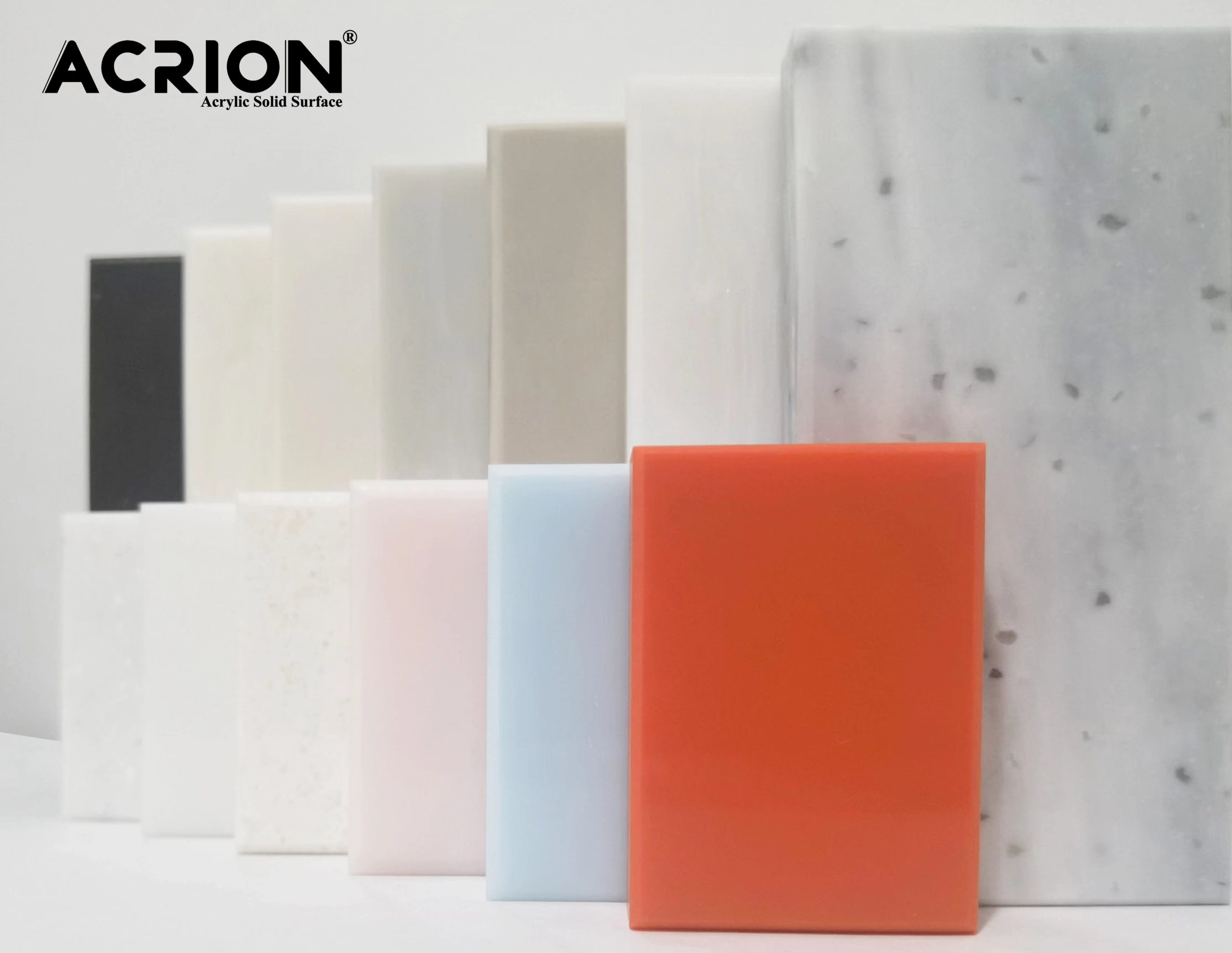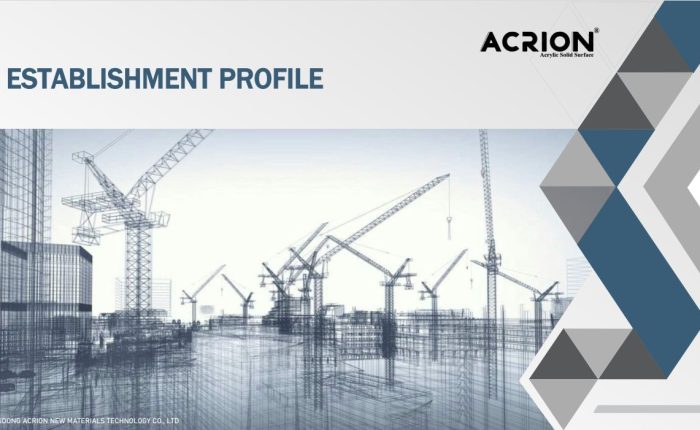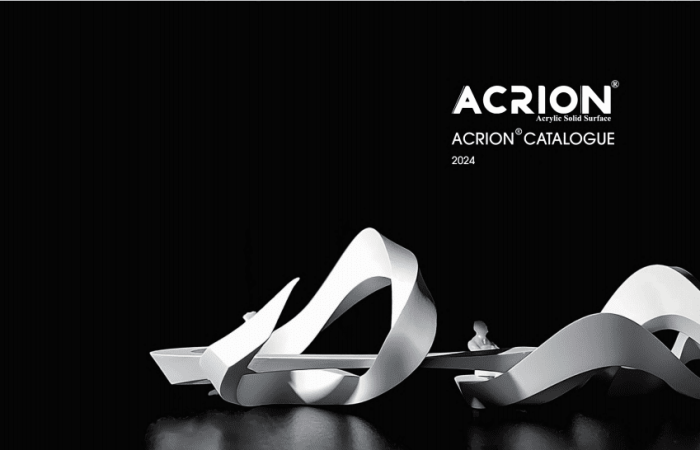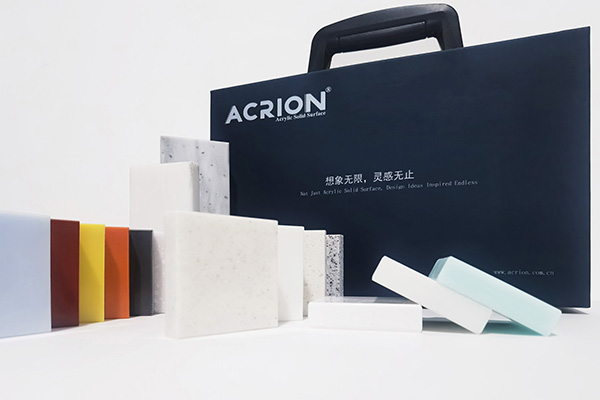يجب تحليل الأداء المقاوم للماء والتأثير المقاوم للرطوبة من الأسطح الصلبة الأكريليك من ثلاثة أبعاد: التركيب الكيميائي للمادة ، وآلية التفاعل الواجهة ، وخصائص التفاعل البيئي. يجب التحقق من فعاليتها الوقائية بالاشتراك مع الاختبارات المختبرية والسيناريوهات الفعلية. فيما يلي تفصيل منهجي من ثلاثة جوانب: مصادر الأداء وطرق الاختبار وأساليب الفشل:
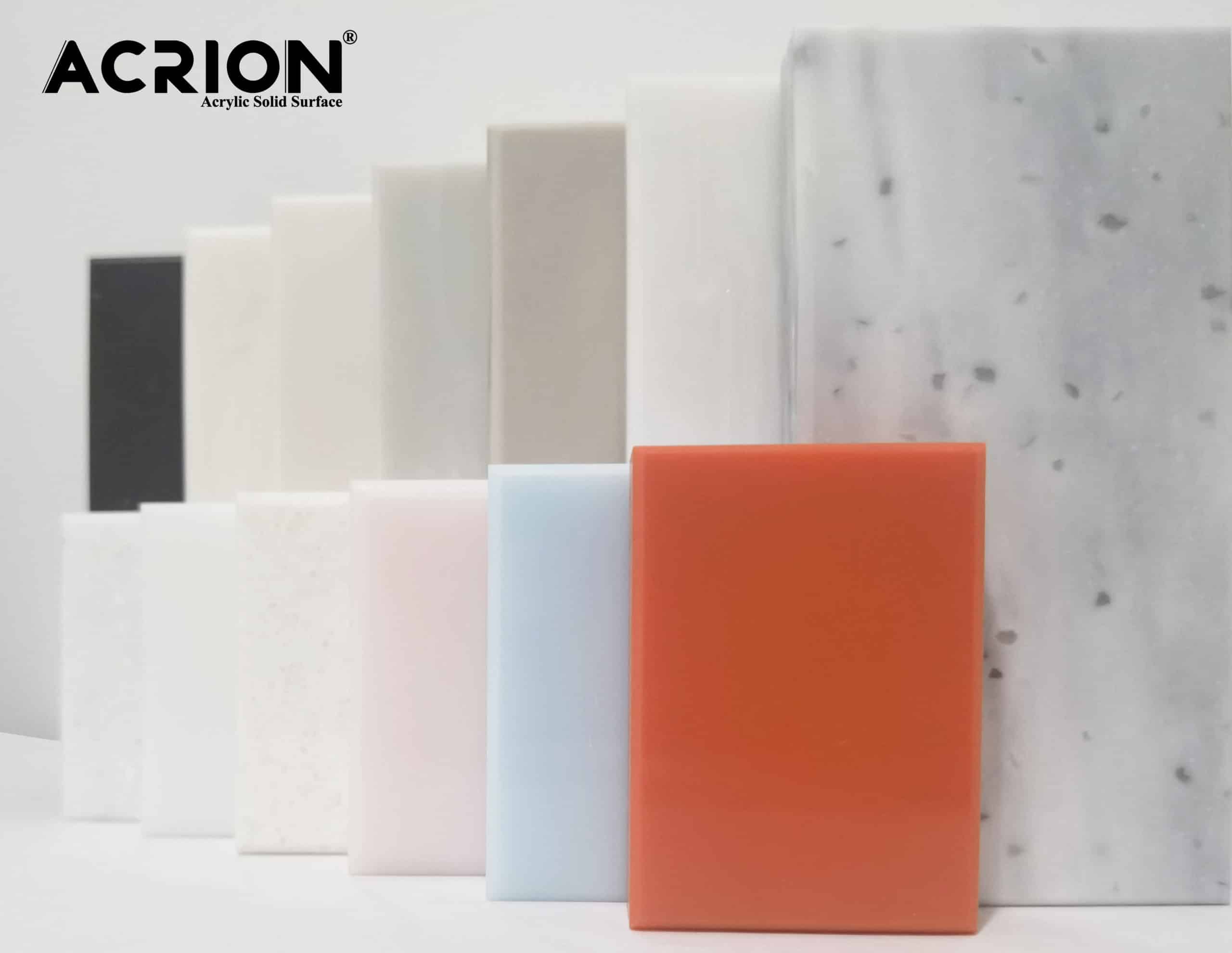
أولاً ، الأساس الكيميائي والخصائص الهيكلية للأداء المضاد للماء
خصائص الطاقة السطحية المنخفضة
يؤدي فرق القطبية بين مجموعة الإستر (-COO-) وسلسلة الألكيل (-CNH2N+1) في راتنجات الأكريليك إلى قوة جزيئية ضعيفة نسبيًا ، مما يمنع سطح الطلاء مع طاقة سطحية منخفضة تتراوح بين 15-30 مليون/م. على سبيل المثال ، يمكن أن تصل زاوية ملامسة الماء لطلاء الأكريليك النقي إلى 90 درجة -105 درجة ، وتقدم قطرات الماء على السطح حالة كروية تقريبًا ، مما يقلل بشكل كبير من ميل الترطيب.
بنية الشبكة المتقاطعة
يمكن للشبكة المتقاطعة ثلاثية الأبعاد التي تشكلها مونومرات متعددة الوظائف (مثل ثلاثي هيدروكسي ميثيل بروبان) أن تمنع تغلغل جزيئات الماء. على سبيل المثال ، يمكن أن يكون للطبقة ذات كثافة التشابك البالغة 80 ٪ معدل امتصاص الماء الذي يقل عن 0.5 ٪ ، وهو أقل بكثير من 3 ٪ -5 ٪ من البوليمرات الخطية.
البناء النانو الصغير
يمكن تحقيق التأثيرات الفائقة من خلال تشكيل بنية خشنة من 50-200 نانومتر على سطح الطلاء من خلال فصل الطور أو طريقة القالب. على سبيل المثال ، يمكن أن يؤدي إدخال ميكروفات الفلور البوليمر إلى الطلاء الاكريليك إلى زيادة زاوية ملامسة الماء إلى أكثر من 150 درجة وزاوية التدحرج إلى أقل من 5 درجات.
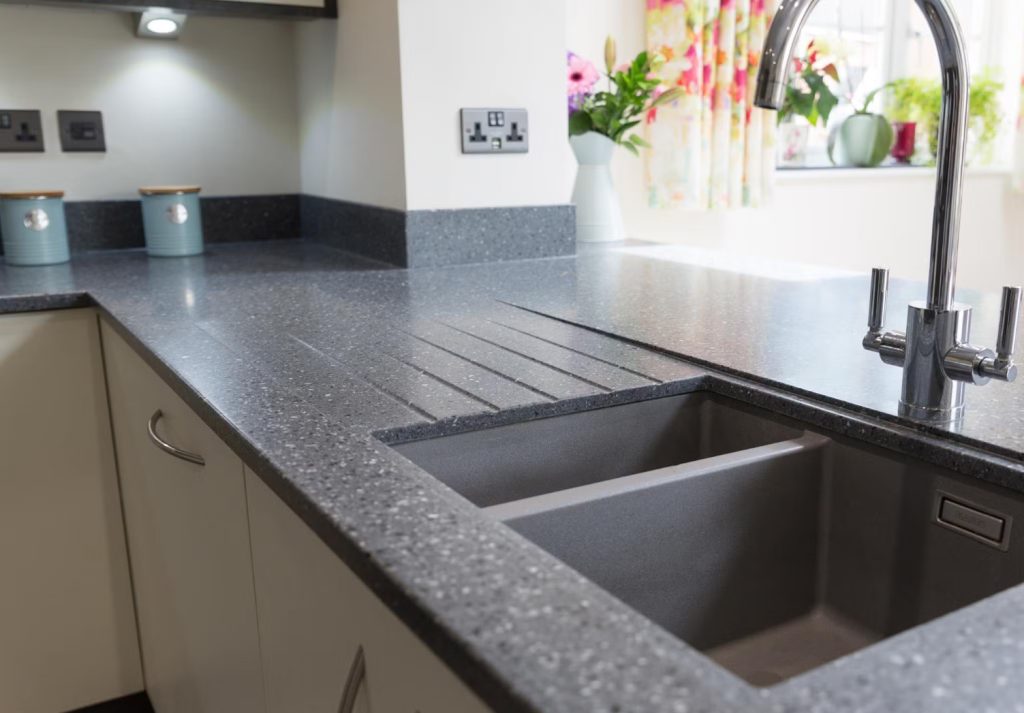
ثانياً ، الآلية والعوامل المؤثرة في تأثير مقاومة الرطوبة
حاجز نشر جزيء الماء
يمكن للهيكل الكثيف المرتبط بتمديد مسار انتشار جزيئات الماء. على سبيل المثال ، في بيئة بنسبة 85 ٪ RH ، يمكن أن يصل معدل نقل بخار الماء (WVTR) للطلاء المتقاطع إلى 1 جم/(M² · 24 ساعة) ، في حين أن معدل الطلاء المرتبط بـ Uncross قد يصل إلى 5 جم/(M² · 24 ساعة).
التصاق البيني متوازن
يجب أن يكون التصاق بين الطلاء والركيزة أكبر من طاقة الامتزاز لجزيئات الماء في الواجهة. على سبيل المثال ، عندما يصل الالتصاق إلى 3 ميجا باسكال ، يمكن أن يقاوم الاختراق البيني لجزيئات الماء في حدود -20 ℃ إلى 60 ℃ ، وتجنب ظاهرة التنقل.
القدرة على التكيف البيئي
سوف تؤثر التغيرات في درجة الحرارة على معامل التمدد للطلاء والتوتر السطحي للمياه. على سبيل المثال ، في -10 ℃ ، تتناقص الطاقة الحركية لجزيئات الماء ، مما قد يزيد من تكثيف التكثيف في micropores للطلاء. في 40 ℃ ، يزداد ضغط بخار الماء ، ويحتاج إلى كثافة تشابك أعلى للحفاظ على مقاومة الرطوبة.
ثالثًا ، طرق الاختبار للأداء المقاوم للماء والرطوبة
قياس زاوية الاتصال الثابت
باستخدام مقياس زاوية التلامس البصري ، تم إسقاط 2 ميكرولتر من الماء منزوع الأيونات في ظل ظروف 25 ℃ و 50 ٪ RH ، وتم تسجيل التغييرات في زاوية التلامس في غضون 30 ثانية. على سبيل المثال ، يمكن أن تصل زاوية التلامس الأولية لطلاء الأكريليك عالي الجودة إلى 100 درجة ، ويكون التغيير أقل من 2 درجة في غضون 60 ثانية.
تجربة امتصاص الماء الديناميكي
نقع العينة المطلية في الماء منزوع الأيونات ووزنها بانتظام لتسجيل تغييرات الجودة. على سبيل المثال ، بعد 24 ساعة من النقع ، يمكن اعتبار الطلاء مع معدل امتصاص الماء أقل من 0.8 ٪ مقاومة جيدة للماء. إذا تجاوز معدل امتصاص الماء 2 ٪ ، فقد يكون هناك عيوب مسام صغيرة.
اختبار دورة الرطوبة العالية
تداول لمدة 24 ساعة بين 85 ٪ RH و 40 ℃ و 25 ٪ RH و 20 ℃ لمدة 100 مرة على التوالي. لاحظ ما إذا كان الطلاء يظهر بثور أو تلون أو انخفاض في التصاق. على سبيل المثال ، إذا انخفض الالتصاق بمزيد من الصف 1 بعد الدورة الدموية (بواسطة طريقة الشبكة).
اختبار معدل نقل بخار الماء
وفقًا لمعيار ASTM E96 ، تم تحديد WVTR بواسطة طريقة الكأس أو طريقة مستشعر الأشعة تحت الحمراء. على سبيل المثال ، في ظل ظروف 38 ℃ و 90 ٪ RH ، فإن الطلاء مع WVTR أقل من 2 جم/(M² · 24 ساعة) مناسبة للسيناريوهات ذات متطلبات عالية الرطوبة.
الرابع ، أوضاع الفشل واستراتيجيات التحسين
عيوب الطلاء تسبب الاختراق
يمكن أن تسبب الثغرات أو الفقاعات فشل العزل المحلي. على سبيل المثال ، يمكن أن تؤدي الثقوب التي يبلغ قطرها 0.1 مم إلى زيادة معدل امتصاص الماء الإجمالي للطلاء بنسبة 30 ٪. تتضمن طرق التحسين تحسين عملية الرش (مثل زيادة ضغط الانحدار إلى 0.3 ميجا باسكال) أو اعتماد طلاء متعدد الطوائف.
واجهة debonding تؤدي إلى الفشل
إن امتصاص جزيئات الماء في واجهة طلاء-سوبستريت سوف يضعف الالتصاق. على سبيل المثال ، على الركيزة الخرسانية ، إذا لم يتم إجراء علاج تمهيدي ، فقد ينخفض التصاق بنسبة 40 ٪ بعد ستة أشهر. تشمل الحلول استخدام مروجي الالتصاق أو زيادة سمك الطلاء إلى أكثر من 150 ميكرون.
التآكل الكيميائي يضر الهيكل
البيئات الحمضية والقلوية سوف تسرع التحلل المائي للطلاء. على سبيل المثال ، بعد الانغماس في محلول حمضي مع درجة الحموضة = 2 لمدة 72 ساعة ، قد تنخفض كثافة الارتباط المتقاطع للطلاء بنسبة 25 ٪. تشمل اتجاهات التحسين إدخال مجموعات مقاومة للتحلل المائي (مثل السيلوكسان) أو زيادة صلابة الطلاء إلى أكثر من 2 ساعة.
الخامس ، التحقق من سيناريوهات التطبيق الفعلي
بناء حماية الجدار الخارجي
في المناطق الممطرة ، من الضروري التحقق من مقاومة الطلاء لتآكل مياه الأمطار. على سبيل المثال ، من خلال اختبار الرش الذي يحاكي 10 سنوات من الأمطار (حوالي 3000 ملم) ، لاحظ ما إذا كان الطلاء يظهر مسحوقًا أو تقشيرًا.
تغليف المعدات الإلكترونية
بالنسبة لبيئات الرطوبة العالية (مثل 85 ٪ RH ، 85 ℃) ، من الضروري اختبار التأثير الوقائي للطلاء على لوحة الدائرة. على سبيل المثال ، بعد اختبار لمدة 1000 ساعة ، يجب أن تظل مقاومة العزل للوحة الدائرة المحمية بواسطة الطلاء الخالي من الرطوبة أعلى من 10¹² Ω.
مكافحة التآكل من المرافق تحت الأرض
في سيناريو تسلل المياه الجوفية ، من الضروري تقييم مقاومة إزالة الكاثودية للطلاء. على سبيل المثال ، بعد الحفاظ عليها بإمكانية -1.5 فولت لمدة 28 يومًا ، يجب أن يكون نصف قطر التقشير بين الطلاء والركيزة المعدنية أقل من 5 مم.
